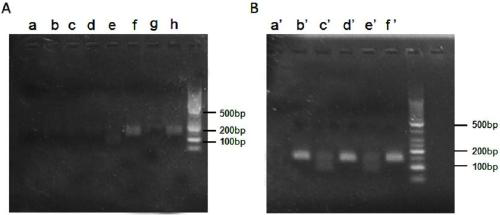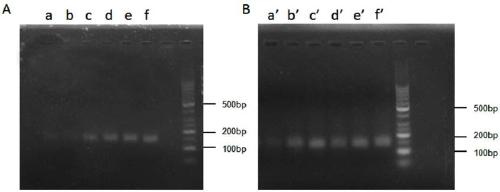Method for detecting enteropathogenic bacteria (salmonella) through seven-channel chip and application
A Salmonella and chip detection technology, applied in the field of microbial detection, can solve the problems of high cost and complicated operation, achieve the effects of short reaction time, low reaction temperature, and avoid refrigerated transportation
- Summary
- Abstract
- Description
- Claims
- Application Information
AI Technical Summary
Problems solved by technology
Method used
Image
Examples
Embodiment 1
[0084] This example is used to illustrate the specificity and sensitivity of the Salmonella RPA method.
[0085] 1. Salmonella primer and probe design
[0086] Primers were designed according to the InvA gene encoding the secreted protein of Salmonella, and the published InvA gene sequence (NC_003198.1) was searched through NCBI. According to the conservative region, after homology analysis, select such as figure 1 Design primers and probes for the indicated fragment (133bp):
[0087] Forward primer: 5’-TACCGGGCATACCATCCAGAGAAAATCGGGCCGC-3’ (34bp)
[0088] Reverse primer: 5’-ATTGGCGATAGCCTGGCGGTGGGTTTTGTTGT-3’ (32bp)
[0089] The sequence information of the probe is as follows:
[0090] 5’-CTCTATTGTCACCGTGGTTCAGTTTATCGTTATTACCAAAGGTTC A-3’
[0091] Among them, the 30th T is labeled with carboxyfluorescein FAM, the 34th T is modified with a quencher group BHQ, the 31-33 TAT is replaced with tetrahydrofuran, and the 3'end is modified with a phosphate group -P. (The modification was done b...
Embodiment 2
[0108] This example is used to illustrate the sensitivity of the Salmonella real-time RPA reaction system.
[0109] According to the instructions of the TwistAmpTM DNA amplification kit, add 2.1 μL of 10 μM forward primer, 10 μM reverse primer 2.1 μL, 10 μM probe 0.6 μL, buffer 29.5 μL, and 12.2 μL distilled water to a 50 μL reaction system. In the EP tube containing the recombinase, polymerase and single-chain polymerase, the last 1 μL of template and 2.5 μL of MgAc at a concentration of 280 mM were added to the EP tube, covered with a lid, and centrifuged, shaking repeatedly 10 times, and centrifuged. Place in a real-time fluorescent PCR machine for isothermal amplification at 39°C, and incubate for 30 minutes.
[0110] Set the template gradient of Salmonella to 100pg / μL, 10pg / μL, 1pg / μL, 100fg / μL, 10fg / μL, 1fg / μL and 0.1fg / μL. As the negative control, two sterile distilled water was selected.
[0111] From Figure 5 It can be seen that when the template concentration is 0.1fg / μL...
Embodiment 3
[0113] This example is used to illustrate the RPA detection of Salmonella in the seven pipelines.
[0114] The specific dimensions of the microchannel in the seven-channel chip are (width: 500 μm, height: 500 μm, length: 2 cm).
[0115] Real-time RPA system, add 2.1 μL of 10 μM forward primer, 10 μM reverse primer 2.1 μL, 10 μM probe 0.6 μL, buffer 29.5 μL, and 12.2 μL distilled water to a 50 μL reaction system. In the EP tube of polymerase and single-chain polymerase, the last 1 μL of template and 2.5 μL of MgAc at a concentration of 280 mM were added to the EP tube, covered with a lid, and centrifuged, shaking repeatedly 10 times, and centrifuged.
[0116] Set the template gradient of Salmonella as 10pg / μL, 1pg / μL, 100fg / μL, 10fg / μL, 1fg / μL and 0.1fg / μL. As the negative control, two sterile distilled water was selected.
[0117] Use a pipette to pipette 5μL of the above system into the microchannel, seal the inlet and outlet with scotch tape or uncured polydimethylsiloxane to preve...
PUM
| Property | Measurement | Unit |
|---|---|---|
| Sensitivity | aaaaa | aaaaa |
Abstract
Description
Claims
Application Information
 Login to view more
Login to view more - R&D Engineer
- R&D Manager
- IP Professional
- Industry Leading Data Capabilities
- Powerful AI technology
- Patent DNA Extraction
Browse by: Latest US Patents, China's latest patents, Technical Efficacy Thesaurus, Application Domain, Technology Topic.
© 2024 PatSnap. All rights reserved.Legal|Privacy policy|Modern Slavery Act Transparency Statement|Sitemap



